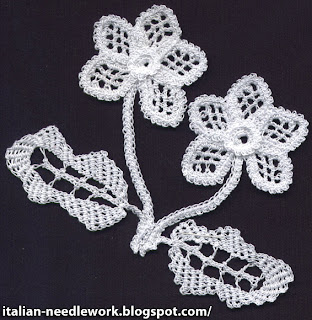I recently made a great find on the Italian version of
ebay,
Il Nuovo Libro dei Lavori Femminili, Volume Primo [The New Book of Woman's Works, First Volume] by
Amelia Brizzi Ramazzotti,
Sonzogno,
Milan. The first volume of an
old Italian needlework encyclopedia from 1911:
Now, I thought, it's probably a lot like the
DMC encyclopedia which pre-dates it by a few years but it will be interesting to have all the same - I was wrong - the illustrations are drawn in a similar style but that's about it. This book definitely has Italian taste where needlework is concerned!
Check out the delightfully strange creature for embroidery on Tulle:
I love the softening of the straight lines of hemstitching with these lovely floral patterns:
Some of the drawn-threadwork section looked familiar... I found it had been previously published in the weekly women's journal
Il Ricamo, No. 1, 1906 which was also published by
Sonzogno. In the 1906 journal it says that the article is a continuation from
Il Ricamo No. 53, 1905. Unfortunately
Elena at
Italian Needlecrafts doesn't have that issue so I can't check it out (she has generously put up scans of many issues though, have a look when you get the chance!). However it would seem that the author
Amelia Brizzi Ramazzotti had material for this particular encyclopedia well before it's publication in 1911. The preface of the encyclopedia says only that she saw the need for a book which had all the techniques of women's work complied together, not that she had taken material from existing publications though it would seem reasonable that she collected material from the same publishing house and a journal that she was the director of.
This is a pattern for
bretelle which are braces embroidered in
Stem Stitch... I wonder what it would be applied to... an apron? Worn over a blouse? If you know, please leave a comment below!
The book has five sections: sewing; whitework; coloured work which has four sub-sections: silk embroidery, goldwork, beadwork, paillettework; drawn-threadwork and Hardanger. In the silk embroidery section there is also silk-ribbonwork featuring many designs with complex compositions of silk-ribbon flowers:
It is a great addition to my library and I hope one day to find the second volume which has chapters on: Embroidery on Tulle; Filet work; Knitting; Crochet; Macramé, Tatting; Bobbin Lace, Renaissance Lace, Teneriffe Lace and Needle Lace.
The author
Amelia Brizzi Ramazzotti (1872 - 1945) edited and/or wrote several publications in the early 20th century and was the director of the needlework journal
Il Ricamo [Embroidery] and
Il Ricamo Moderno [Modern Embroidery] during the same period. I have been unsuccessful in finding out much on the life of
Amelia Brizzi Ramazzotti, if you know anything would you leave a comment below?
I've been corresponding with assistant professor
Dr. Silvia Valisa at the
State University of Florida who is researching old publications from the
Sonzogno publishing house of
Milan. She is involved in
Project Sonzogno which is trying to collect at least one copy of every old
Sonzogno publication for the
Sonzogno Historical Library and compiling a catalogue listing of the old publications. Whenever you come across an old
Sonzogno publication, please contact her if you don't see it in her catalogue listings either
here or
here.
































